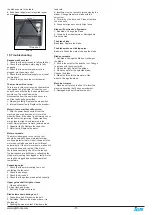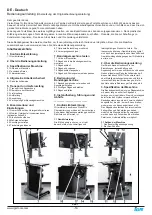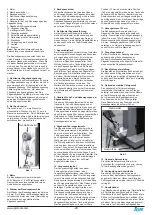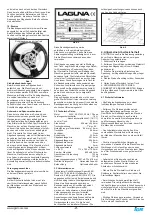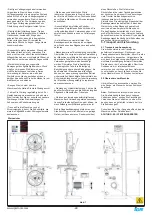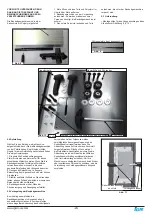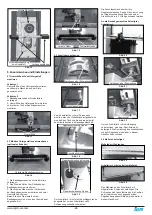
-12-
www.igmtools.com
Adjusting the fence for drift
Method 1
1. Make a straight pencil line on the edge of a
board.
2. Feed the wood into the blade cutting next
to the pencil mark. If the blade is drifting, you
will have to compensate by angling the wood
to keep the cut straight.
3. Stop the cut in the middle of the wood and
mark (with pencil) the angle on the table. This
is the angle of drift, and you will have to set the
fence to the pencil line.
4. To adjust the fence, loosen the clamp bolts
that attach it to the cast bracket. Move the
fence so that it lines up with the pencil mark on
the table and retighten the clamp screws.
Pic. 51
Method 2
1. Set the fence parallel with the blade by
loosening the clamp screws that hold it to the
cast bracket. It is not important that it is exact
because you will be readjusting later in the
procedure.
2. Using a piece of scrap wood, make a cut
while holding the wood against the fence. Stop
the cut in the middle of the wood.
3. Look at the position of the back of the blade
within the saw cut. The back of the blade
should be in the center of the slot, but you will
probably find that it is closer to one side.
4. Slightly loosen the clamp screws and adjust
the fence to compensate. Repeat steps 2, 3
and 4 until the blade is centered.
Note
: You may have to do several fine
adjustments, and it is better to do several small
adjustments until you become skilled at the
procedure. Once you have mastered the
process, it should only take a minute to perform
the adjustment.
Note
: Each blade has a slightly different drift,
and each time you change a blade, you must
check and readjust if necessary.
Note
: It is worth taking the time to set the fence
accurately as it will save frustration and
enhance the performance of your machine.
Adjusting the table rule
There is a rule that is fitted to the side of the
table and can be used as a quick guide on the
distance that the fence is from the blade.
Note
. The rule will have to be adjusted each
time the fence is adjusted for drift, as this will
change the distance the fence is from the
blade.
Once the fence has been adjusted for drift:
1. Lock the fence to the rail.
2. Measure the distance from the front of the
blade to the fence.
3. Check the distance indicated on the rule.
4. Loosen the clamp bolts and adjust the rule.
5. Tighten the clamp bolts and recheck.
Pic. 52
Pic. 53
Fence position
Fence in low position
Pic. 54
Fence in high position
Pic. 55
The aluminum fence can be used in two height
positions (high and low). The low position is
handy for cutting thin wood and is used where
the fence in the high position would make it
awkward to complete cuts. The fence in the
high position is used for supporting tall work.
Changing the fence height.
1. Loosen the clamp screws that are located on
the cast bracket.
2. Slide the aluminum fence off the cast iron
bracket.
3. Slide the aluminum fence back onto the
bracket using the second slot and retighten the
clamp screws.
Resawing.
Resawing is the process of cutting a board in
half along its height. The bandsaw is perhaps
the most creative tool in the shop because of
its ability to cut thick or thin, straight or curved.
The ability to cut thick stock such as re-sawing,
making veneers, book matching or cutting
flitches from small logs has great appeal to the
woodworker. These capabilities greatly enhance
he woodworker’s design ability without the
need for additional equipment. When a board
is resawed and the two pieces are lying next
to each other, you will note that they are mirror
images of each other. When these two boards
are glued together, it is called bookmatching.
Note: It is unsafe to cut wood that is
unsupported by the table and should never
be attempted. This is especially important to
note when cutting round logs.
8.2 Selecting the Right Blade
Introduction
The selection and use of blades is a very
extensive subject, and there have been many
books written on it. This section of the manual
is intended as a general guide only.
Selecting a blade
Using the correct blade is important, as it is the
first step in attaining good bandsaw
performance. The most frequently asked
question is „How do I decide on the correct
blade to use?“ The answer is not simple, and
we will explore it in this section of the manual.
Firstly, there is
NO
ideal blade that will do
everything. The blades that you choose will be
determined by the type of work that you are
doing. Large-tooth wide blades are selected
for fast course cuts, and fine, thin blades are
used for intricate scrollwork. You will find that
you will need a large selection of blades if you
do a lot of varied work and fewer blades if you
are concentrating on one section of bandsawing
such as re-sawing. Using the wrong blade is the
best way to abuse it. Using a blade for its
intended purpose allows for maximum efficiency
and is the best way to prolong its life.
Blade terms
The amount that the teeth are wider than the
thickness of the backing material. The larger
the set, the larger the saw cut and the smaller
the radius that can be cut. This can also be
an advantage if you are cutting a job that has
a tendency to nip the blade. The smaller the
set, the smaller the saw cut and the larger the
radius that can be cut; the wood waste is less.
On tipped blades (Resaw King) there is no set,
as the tip is wider than the backing material.
Thickness
The thicker the blade, the stiffer the blade and
the straighter the cut. The thicker the band, the
greater the tendency for the blade to break.
Pitch
The size of the teeth. This is usually quoted in
teeth per inch (TPI). The larger the tooth, the
faster the cut because the tooth has a large
gullet and has a greater capacity to transport
large amounts of sawdust through the job. The
larger the tooth, the coarser the cut and the
poorer the surface finish of the cut. The smaller
the tooth, the slower the cut as the tooth has
a small gullet and cannot transport large
amounts of sawdust through the job. The
smaller the tooth, the finer the cut and the
better the surface finish of the cut
Table rule
Adjustment slot
Correct
Adjust

















